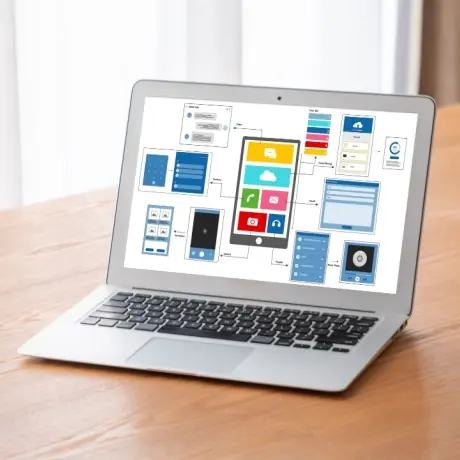Inclusive UX design is about creating digital experiences that welcome everyone. It ensures users of all abilities, backgrounds, and preferences can engage fully with websites, apps, and digital products. Inclusive UX design is about being ethical and is a smart business strategy. Today, brands and businesses realize that accessible, user-centered design can expand their reach, boost engagement, and enhance loyalty.
In the world of UX design, achieving inclusivity means overcoming unique challenges. UX researchers often struggle to understand user needs. Especially when designing websites that work for everyone. However, through thoughtful user research, they can address these challenges and help businesses create truly universal experiences. Whether working with a UX research agency or taking an in-house approach, inclusive design requires a focus on accessibility and adaptability.
This article will cover key topics, including the core principles and essential elements of inclusive UX design. We’ll also explore the business benefits and best practices for implementing it effectively. Lastly, we’ll look at ways to measure the success of your inclusive UX approach, so you can see the impact on your users and your business.

Key Principles of Inclusive UX Design
Inclusive UX design is grounded in core principles that ensure digital experiences are accessible, user-friendly, and fair to all users. By following these principles, UX designers can create products that benefit everyone. This leads to better user satisfaction and business growth.
1. Flexibility
Flexibility in inclusive UX design means creating adaptable interfaces that adjust to different user needs. Allowing users to customize settings or interact in different ways supports individual preferences and makes product design more inclusive.
2. Equity
Equity ensures equal access and ease of use for everyone, regardless of background or ability. Inclusive UX design uses universal design principles to reduce barriers, giving all users a fair chance to engage with the user interface and experience.
3. Clarity
Clarity is essential in inclusive design, as it presents information in an easy-to-understand way. Using straightforward language, intuitive layouts, and thoughtful visual design allows UX designers help users find what they need without confusion.
4. Accessibility
Accessibility in inclusive UX design involves implementing features that support users with disabilities. By adding tools like screen readers, text-to-speech options, or keyboard navigation, designers make the user experience accessible for all abilities.
5. User-Centricity
User-centricity means designing with diverse users in mind from the start. By involving various perspectives in the user research and design process, UX designers can create intuitive and supportive interfaces, that benefit all types of users.
Each of these principles helps create an inclusive design that enhances user experience and supports business goals by driving retention and satisfaction. Embracing these elements in UX design offers a win-win for users and businesses.

Essential Elements of Inclusive UX Design
Inclusive UX design relies on key elements that make digital experiences accessible and enjoyable for everyone. By focusing on accessibility, readability, responsive design, clear navigation, and testing with diverse users, brands can create an inclusive design for all users and support ideal use across different needs.
1. Accessible Content
Accessible content includes text alternatives, captions, and transcripts for multimedia. This approach allows users with disabilities to access information through their preferred formats. With accessible design, UX-inclusive design ensures content is available to everyone.
2. Responsive Design
Responsive design means creating interfaces that adapt to various devices and screen sizes. By using flexible layouts and scalable visuals, inclusive UX design provides a seamless user experience across phones, tablets, and desktops, enhancing universal design.
3. Clear Navigation
Clear navigation ensures that users can easily find their way around. With well-labeled links and simple paths, inclusive design reduces frustration and supports a smooth journey, allowing users to access what they need quickly.
4. Readability
Readability involves using easy-to-read fonts, colors, and layouts. Inclusive UX design prioritizes clarity, so all users can understand content without strain, supporting accessibility and making information enjoyable to engage with.
5. Testing with Diverse Users
Testing with diverse users means evaluating interfaces with people of different backgrounds and abilities This commitment to accuracy in inclusive UX design helps designers find and fix issues, ensuring the design meets varied needs. One important point to remember is that user testing must happen regularly.
Incorporating these elements into inclusive UX design enhances usability and appeals to a wider audience. This thoughtful design approach attracts more users, boosts engagement, and shows a brand’s commitment to inclusivity.

Commercial Benefits of Inclusive UX Design
Inclusive UX design offers businesses both financial and reputational value. By focusing on accessibility and inclusivity, companies can expand their audience, enhance their brand image, and boost conversions. Inclusive UX design is a wise investment that promotes sustainable business growth while meeting the needs of a diverse user base.
1. Expanded Market Reach
By catering to users of all abilities and demographics, inclusive UX design opens doors to a broader audience. This approach allows businesses to engage users who might otherwise struggle, expanding their market reach significantly.
2. Enhanced Brand Reputation
Inclusive UX design builds a brand known for inclusivity and social responsibility. When companies show commitment to accessibility, they attract positive attention, enhancing their image and setting themselves apart from competitors.
3. Higher Conversion Rates
With improved accessibility and usability, inclusive UX design drives user engagement and boosts conversions. When users find a product easy to navigate, they’re more likely to complete actions, increasing the business’s revenue potential.
4. Regulatory Compliance
Inclusive UX design helps businesses meet accessibility standards, reducing the risk of legal issues. By following regulations, companies avoid penalties and demonstrate their commitment to accessibility and social responsibility.
5. Customer Loyalty
Users who value inclusivity are likelier to stay loyal to brands that reflect these values. Inclusive UX design fosters long-term relationships with customers who appreciate ethical business practices.
6. Improved User Experience
this design approach enhances the overall user experience for everyone, not just those with disabilities. By prioritizing usability, businesses create products that serve the ideal user experience for all, leading to increased satisfaction.
7. Cost Savings on Support
Clear, accessible designs reduce the need for extensive customer support. When users can easily navigate and understand a product, fewer support resources are required, resulting in cost savings.
8. Increased Engagement and Interaction
Users who can fully engage with a product are likelier to interact frequently. Inclusive UX design, supported by usability testing and prototyping, encourages higher engagement levels, benefiting both users and businesses.
9. Attracting Diverse Talent
A commitment to inclusive UX design can attract a design team passionate about accessibility and social impact. Hiring a UI UX design agency or team with this focus also brings fresh perspectives that benefit the design process.
10. Future-Proofing Against UX Trends
Incorporating AI in UX design and considering sustainability in UX design trends makes products adaptable for the future. Inclusive UX design prepares companies for changes in universal design vs. inclusive design practices, ensuring long-term relevance.
Investing in inclusive UX design brings financial and reputational advantages to a business. It attracts a wider audience, builds trust, and increases conversions, making it a smart choice for sustainable growth.

Best Practices for Implementing Inclusive UX Design
Implementing inclusive UX design requires a clear focus on user needs, collaboration, and continuous improvement. Following best practices helps businesses create accessible experiences. Especially ones that engage as many users as possible. Hiring a UI UX design agency that understands inclusive design helps ensure a professional approach and greater success.
1. User Research
Conduct user research to understand the needs of diverse audiences, including those with disabilities. Gathering insights from varied user groups helps UX professionals make informed design decisions that address the specific requirements of the ideal user.
2. Iterative Testing
Testing with real users, including those with disabilities, provides essential feedback. Iterative testing allows teams to identify areas for improvement and adjust designs, making websites and apps more accessible for all users over time.
3. Cross-Functional Collaboration
Design, development, and content teams collaborate to weave inclusive design principles into every stage. By working together, the design team can make cohesive and accessible design decisions that benefit all users.
4. Ongoing Education
Keeping teams updated on accessibility standards and best practices in inclusive design is essential. Regular training helps team members understand the importance of designing for accessibility and stay committed to creating inclusive experiences.
Encouraging businesses to adopt these best practices in inclusive UX design enhances user experience and keeps them competitive. Working with a UX design agency experienced in inclusive design ensures the process is expertly managed, leading to more effective, user-friendly outcomes.

Measuring the Success of Inclusive UX Design
To measure the success of inclusive UX design, businesses track key metrics to assess effectiveness and ROI. By focusing on engagement, compliance, conversion rates, and feedback, companies can ensure their design goes beyond accessibility, creating a human-centered experience.
1. User Engagement and Satisfaction Scores
Surveys and feedback tools measure satisfaction, especially among disabled and marginalized groups. High scores show that websites and apps meet diverse needs, proving the value of inclusive design.
2. Accessibility Compliance Levels
Achieving standards like WCAG (Web Content Accessibility Guidelines) and local regulations is essential. Meeting these guidelines shows a commitment to accessibility, providing real-world examples of inclusive design solutions.
3. Conversion Rates and Market Growth
Tracking conversion rates reveals how inclusive UX design influences user interaction and growth in underserved segments. Increased conversions show that the design resonates with a wider audience, expanding market reach and revenue.
4. Feedback Loop Analysis
Continuous feedback analysis helps businesses adapt their design as needed. This ongoing process supports a sustainable, inclusive experience by using user input for future updates, reinforcing a human-centered design approach.
Evaluating inclusive UX design requires tracking engagement, compliance, and feedback. These metrics ensure that the design meets accessibility needs and supports business goals, adding value for all users

Inclusive UX Design: A Smart Choice for Growth
Inclusive UX design goes beyond ethics; it’s a powerful business strategy. By following best practices, such as accessibility, clear navigation, and testing with diverse users, companies can create experiences that engage a wide audience, foster loyalty, and enhance brand reputation. This approach drives conversions, reduces support costs, and builds strong customer relationships. Embracing inclusivity is an ongoing journey, as evolving user needs demand continuous improvements. This commitment is the right thing to do and a smart way for businesses to stay competitive.
At ScreenRoot, awarded the ‘UI UX Digital Agency of the Year 2024,’ we understand the importance of inclusive design. From UI UX audits and usability testing to designing for next-gen devices, we’re here to bring your vision to life. Visit our Work page here to explore our projects and capabilities. Ready to make inclusivity a part of your UX strategy? Contact us at 1800 121 5955 (India), email [email protected], or connect through our Contact Form. Collaborate with us to create user-friendly solutions that reflect your brand’s commitment to inclusivity.







